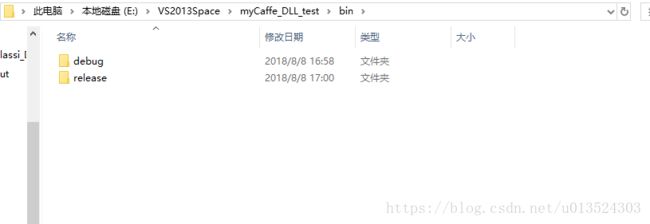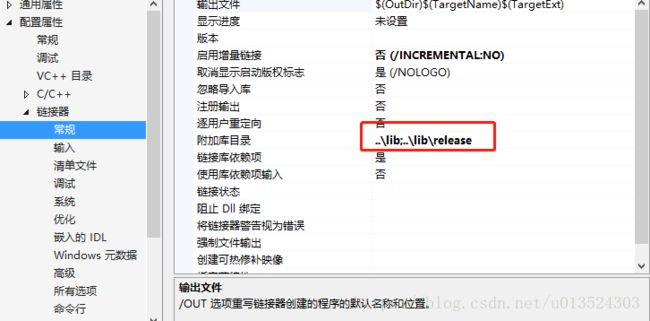caffe的classification封装dll
为了能在自己的项目中调用caffe框架,所以需要将caffe封装成dll。并将封装好的内容拷贝出来,直接放到项目中,项目移植之后同样能工作的起来。遇到了很多坑,没有随手记录的习惯,碰到的一些问题和解决方案不记得了,现在把整个过程记录一下。总之各种坑需要趴!
开始按照https://blog.csdn.net/sinat_30071459/article/details/51823390的方法进行编译的,最终虽然dll编译成功,但是调用的时候却没办法用,一些看不懂的bug,打算重新来过。
遇到release时只生成dll,没有lib的情况。搜了很多也没有找到解决方法。
主要过程就是按照博主z梦飞的神操作进行编译的。
首先建立一个空项目选择dll,省去了之后编译时各种配置的问题。
![]()
新建工程之后就是库目录和包含目录的添加,按照z梦飞的配置会提示有些目录和lib没有加载成功,需要继续添加,这里贴出最后的配置结果。
//include
E:\caffe-master\include;E:\NugetPackages\gflags.2.1.2.1\build\native\include;E:\NugetPackages\glog.0.3.3.0\build\native\include;E:\NugetPackages\protobuf-v120.2.6.1\build\native\include;E:\NugetPackages\OpenCV.2.4.10\build\native\include;E:\NugetPackages\OpenBLAS.0.2.14.1\lib\native\include;E:\NugetPackages\boost.1.59.0.0\lib\native\include;//库目录
//release
E:\caffe-master\Build\x64\Release;E:\NugetPackages\OpenCV.2.4.10\build\native\lib\x64\v120\Release;E:\NugetPackages\gflags.2.1.2.1\build\native\x64\v120\dynamic\Lib;E:\NugetPackages\glog.0.3.3.0\build\native\lib\x64\v120\Release\dynamic;E:\NugetPackages\OpenBLAS.0.2.14.1\lib\native\lib\x64;E:\NugetPackages\protobuf-v120.2.6.1\build\native\lib\x64\v120\Release;E:\NugetPackages\LevelDB-vc120.1.2.0.0\build\native\lib\x64\v120\Release;E:\NugetPackages\hdf5-v120-complete.1.8.15.2\lib\native\lib\x64;E:\NugetPackages\boost_date_time-vc120.1.59.0.0\lib\native\address-model-64\lib;E:\NugetPackages\boost_filesystem-vc120.1.59.0.0\lib\native\address-model-64\lib;E:\NugetPackages\boost_system-vc120.1.59.0.0\lib\native\address-model-64\lib;E:\NugetPackages\boost_thread-vc120.1.59.0.0\lib\native\address-model-64\lib;E:\NugetPackages\boost_chrono-vc120.1.59.0.0\lib\native\address-model-64\lib;E:\NugetPackages\lmdb-v120-clean.0.9.14.0\lib\native\lib\x64;//debug
E:\caffe-master\Build\x64\Debug;E:\NugetPackages\OpenCV.2.4.10\build\native\lib\x64\v120\Debug;E:\NugetPackages\gflags.2.1.2.1\build\native\x64\v120\dynamic\Lib;E:\NugetPackages\glog.0.3.3.0\build\native\lib\x64\v120\Debug\dynamic;E:\NugetPackages\OpenBLAS.0.2.14.1\lib\native\lib\x64;E:\NugetPackages\protobuf-v120.2.6.1\build\native\lib\x64\v120\Debug;E:\NugetPackages\LevelDB-vc120.1.2.0.0\build\native\lib\x64\v120\Debug;E:\NugetPackages\hdf5-v120-complete.1.8.15.2\lib\native\lib\x64;E:\NugetPackages\boost_date_time-vc120.1.59.0.0\lib\native\address-model-64\lib;E:\NugetPackages\boost_filesystem-vc120.1.59.0.0\lib\native\address-model-64\lib;E:\NugetPackages\boost_system-vc120.1.59.0.0\lib\native\address-model-64\lib;E:\NugetPackages\boost_thread-vc120.1.59.0.0\lib\native\address-model-64\lib;E:\NugetPackages\boost_chrono-vc120.1.59.0.0\lib\native\address-model-64\lib;E:\NugetPackages\lmdb-v120-clean.0.9.14.0\lib\native\lib\x64;//依赖项的添加
//release
libglog.lib
libcaffe.lib
gflags.lib
gflags_nothreads.lib
hdf5.lib
hdf5_hl.lib
libprotobuf.lib
libopenblas.dll.a
Shlwapi.lib
LevelDb.lib
lmdb.lib
opencv_core2410.lib
opencv_highgui2410.lib
opencv_imgproc2410.lib
opencv_video2410.lib
opencv_objdetect2410.lib
//debug
libglog.lib
libcaffe.lib
gflagsd.lib
gflags_nothreadsd.lib
hdf5.lib
hdf5_hl.lib
libprotobuf.lib
libopenblas.dll.a
Shlwapi.lib
LevelDb.lib
lmdbD.lib
opencv_core2410d.lib
opencv_highgui2410d.lib
opencv_imgproc2410d.lib
opencv_video2410d.lib
opencv_objdetect2410d.lib其中opencv使用的是我自己配置的opencv,,其次再添加路径时要根据自己的实际路径添加。
在编译过程中需要在预编译定义中添加
_SCL_SECURE_NO_WARNINGS
否则会出现警告错误。
在新建的项目中添加一个layer.h,用于声明需要用到的caffe中各种layer。
#ifndef LAYER_H
#define LAYER_H
#include "caffe/common.hpp"
#include "caffe/layers/input_layer.hpp"
#include "caffe/layers/inner_product_layer.hpp"
#include "caffe/layers/dropout_layer.hpp"
#include "caffe/layers/conv_layer.hpp"
#include "caffe/layers/relu_layer.hpp"
#include "caffe/layers/pooling_layer.hpp"
#include "caffe/layers/lrn_layer.hpp"
#include "caffe/layers/softmax_layer.hpp"
namespace caffe
{
extern INSTANTIATE_CLASS(InputLayer);
extern INSTANTIATE_CLASS(InnerProductLayer);
extern INSTANTIATE_CLASS(DropoutLayer);
extern INSTANTIATE_CLASS(ConvolutionLayer);
REGISTER_LAYER_CLASS(Convolution);
extern INSTANTIATE_CLASS(ReLULayer);
REGISTER_LAYER_CLASS(ReLU);
extern INSTANTIATE_CLASS(PoolingLayer);
REGISTER_LAYER_CLASS(Pooling);
extern INSTANTIATE_CLASS(LRNLayer);
REGISTER_LAYER_CLASS(LRN);
extern INSTANTIATE_CLASS(SoftmaxLayer);
REGISTER_LAYER_CLASS(Softmax);
}
#endif新建一个myCaffeCliassi类,用于分类任务,代码来源于caffe的classification项目。
因为本文只是使用CPU版的,所以添加了CUP_ONLY的宏定义。
//myCaffeCliassi.h
#ifndef MYCLASS_H_
#define MYCLASS_H_
#define CPU_ONLY 1
#include
#include
#include
#include
#include
#include
#include
#include
#include
using namespace caffe; // NOLINT(build/namespaces)
using std::string;
/* Pair (label, confidence) representing a prediction. */
typedef std::pair<string, float> Prediction;
class _declspec(dllexport) Classifier {
public:
Classifier(const string& model_file,
const string& trained_file,
const string& mean_file,
const string& label_file);
std::vectorfloat> > net_;
cv::Size input_geometry_;
int num_channels_;
cv::Mat mean_;
std::vector<string> labels_;
};
#endif //myCaffeCliassi.cpp
#include "myCaffeCliassi.h"
#include "layer.h"
Classifier::Classifier(const string& model_file,
const string& trained_file,
const string& mean_file,
const string& label_file) {
#ifdef CPU_ONLY
Caffe::set_mode(Caffe::CPU);
#else
Caffe::set_mode(Caffe::GPU);
#endif
//Caffe::set_mode(Caffe::GPU);
/* Load the network. */
net_.reset(new Net<float>(model_file, TEST));
net_->CopyTrainedLayersFrom(trained_file);
CHECK_EQ(net_->num_inputs(), 1) << "Network should have exactly one input.";
CHECK_EQ(net_->num_outputs(), 1) << "Network should have exactly one output.";
Blob<float>* input_layer = net_->input_blobs()[0];
num_channels_ = input_layer->channels();
CHECK(num_channels_ == 3 || num_channels_ == 1)
<< "Input layer should have 1 or 3 channels.";
input_geometry_ = cv::Size(input_layer->width(), input_layer->height());
/* Load the binaryproto mean file. */
SetMean(mean_file);
/* Load labels. */
std::ifstream labels(label_file.c_str());
CHECK(labels) << "Unable to open labels file " << label_file;
string line;
while (std::getline(labels, line))
labels_.push_back(string(line));
Blob<float>* output_layer = net_->output_blobs()[0];
CHECK_EQ(labels_.size(), output_layer->channels())
<< "Number of labels is different from the output layer dimension.";
}
static bool PairCompare(const std::pair<float, int>& lhs,
const std::pair<float, int>& rhs) {
return lhs.first > rhs.first;
}
/* Return the indices of the top N values of vector v. */
static std::vector<int> Argmax(const std::vector<float>& v, int N) {
std::vector<std::pair<float, int> > pairs;
for (size_t i = 0; i < v.size(); ++i)
pairs.push_back(std::make_pair(v[i], static_cast<int>(i)));
std::partial_sort(pairs.begin(), pairs.begin() + N, pairs.end(), PairCompare);
std::vector<int> result;
for (int i = 0; i < N; ++i)
result.push_back(pairs[i].second);
return result;
}
/* Return the top N predictions. */
std::vector */
Blob<float> mean_blob;
mean_blob.FromProto(blob_proto);
CHECK_EQ(mean_blob.channels(), num_channels_)
<< "Number of channels of mean file doesn't match input layer.";
/* The format of the mean file is planar 32-bit float BGR or grayscale. */
std::vector此时进行编译,可以得到dll和lib文件。将这些文件以及myCaffeCliassi.h拷出来备用。
为了使用的方便,新建三个文件夹include,lib,bin;
include:把caffe、opencv等等,之前所有包含目录中所有路径下的.h文件都拷贝进来,最重要的是myCaffeCliassi.h要拷贝进来。
lib:放的是所有用到的lib文件,也包括刚刚编译成功的myCaffeCliassi.lib。但是需要注意的是在所有需要区分debug和release版本的myCaffeCliassi.lib需要区分开来,我是在lib文件夹中新建了debug和release文件夹,分别放需要区分的lib文件。
bin:bin文件夹需要放的是dll文件,同样注意debug和release版本的区别。我是直接将不同的dll放到对应的子文件内。

然后新建一个工程,将include、lib、bin三个文件夹拷到项目的根目录下,进行如图配置:




当然还有_SCL_SECURE_NO_WARNINGS添加到预编译定义中。
然后写一个测试文件.
#include "myCaffeCliassi.h"
#include 不管如何,总算得到如图结果,值得大赦天下一下了。

经过这一顿神操作之后,代码随便放到其他的环境下也能运行的起来了。
过程中遇到很多坑,另起一片博客记录 https://blog.csdn.net/u013524303/article/details/81503756,但有些一时想不起来,等想起来的时候在补充吧。
Reference
https://blog.csdn.net/sinat_30071459/article/details/51823390
https://blog.csdn.net/zff1988927/article/details/56839753